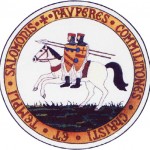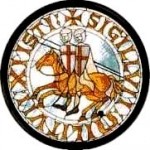History of the OrderPrecepts of the Order and Membership QualificationsExplanations for two knights on one horse seal |
“Poor Fellow-Soldiers of Christ and the Temple of Solomon”by E.Kt. Stafford Coates, P.P.2nd. Con.,
In the Transactions of Quatuor Coronati Lodge for the year 1912, a paper entitled ‘The Templar Legends in Freemasonry’ was presented by the late W.J. Chetwode Crawley G.C.T., of the Great Priory of Ireland. Fully 25 pages long, it calls to the reader’s attention some historical considerations bearing on the question of the Masonic Knights Templar. It attempts, or is intended to throw into relief, the relationship between the various sections of the Order, the Knights Templar, Malta, and the Hospitallers of St. John of Jerusalem. There is, however, one small paragraph, inserted almost as an afterthought, which is of particular interest…….. “… Here occasion may be taken to supply a correction of the current explanation of the device on the Templar’s seal, two horsemen on one horse. The explanation that this device is intended to commemorate the poverty of the Order, which could only afford one horse for each pair of Knights, is due to an unsupported surmise of Matthew Paris. It is flatly contradicted by the Statutes of the Order (drawn up by St. Bernard in 1128) which expressly enjoined that each Knight will be provided with three horses. Even the ‘fraters servientes armiger’, or men-at-arms, of whom a body attended each Knight, were allotted one horse each. Although Matthew Paris’ explanation has been corrected by Stow and other antiquaries, it still survives”. The current Editor of A.Q.C. (R.A. Gilbert) presumes that Stow’s edition of the Matthew Paris’ “Chronicle”, in which the “errors” are corrected, was published in 1571. (For Paris and Stow, see ‘Dictionary of National Biography’)
These “Primitive Rules”, first promulgated in the year 1129, are still in existence in their medieval French language as “La Regle du Temple” and have been translated and published as ‘The Rule of the Templars’ (1). In total, there are 686 Rules under the headings of “The Primitive Rule”, “The Hierarchical Statutes”, “Penances”, Conventual Life”, “The Holding of Chapters”, “Reception into the Order”, to all of which the Templar must adhere, and an appendix, “The Military Manual”. A short summary of some of these Rules, which apply to the “horse” question, are as follows: Rule 77: The Master should have four horses, one chaplain, one clerk with three horses, one sergeant with two horses, one valet with one horse to carry his shield and lance……………. Rule 99: The Seneschal may have four mounts and a mule, one Knight Brother as a companion, who should also have four horses…a sergeant with two horses, a turcopole with one horse………. Rule 101: The Marshal should have four horses and two squires……. Rule 132: Knights Commanders should have four horses…… Rule 138: Each Knight Brother should have three horses and one squire and a second squire and a fourth horse at the discretion of the Master…….he should have a hauberk, iron hose, a helmet, a sword, a shield, a lance, a Turkish mace, a surcoat, an arming jacket, mail shoes, three knives, a dagger, a bread-knife, and a pocket knife…..They may have two shirts, two pairs of (leather) breeches, two pairs of hose, and a small belt over the shirt….and all shall sleep thus, except when ill in hospital, and then only with permission…….. However, on a more modern note: By logging on to: http://www.templarhistory.com/seal.html – one may find a further number of explanations, all of little i) “Two Knights on one horse is a reference to the homosexuality which the Knights were said to practice; an accusation brought against them after their arrest in 1307”. ii) “The seal represents the acceptance into the Order of a candidate who was not authorised to ride a horse. The second was lifted up as an equal by the first, making him equal by his own deserving”. But a much more plausible explanation and an actually recorded event, can be found in studying the ‘surprise’ tactics Richard Lionheart employed against Saladin during the 3rd. Crusade 1192.
The rigorous training imposed on new Knights explains the success of these tactics. This training is outlined in some detail in a book, ‘Deus’, by Philip Boast (2). Although written as a historical novel, it shows deep and through research into the history and ethos of the age… From it I quote: “…I ride to London. I sell my horse, everything except the clothes I stand up in….A bearded man asks me what is my wish of the Order of Poor Fellow-Soldiers of Christ… After many days of repeated trials and tribulations, the successful applicant undergoes exhaustive military training, being taught to fight both left and right-handed, on foot and on horse, with all weapons. Even the war-horses (from which Shire, Clydesdale, and Suffolk Punch breeds are descended) were taught to kick and bite the foe. Again I quote from the same book; “….I am fortunate in my timing. My induction into the Templars was swift…because of my left-handedness….. In battle we fight two to each horse, a sword to the right and to left and cloaks flying on each side, which is how the legend of the (Templars) winged horse arose…..” Now picture the scene: one thousand shire horses in full war panoply, two thousand swords and lances, two thousand cloaks flying, all at the charge……. No wonder Saladin was grieved and anxious!
In ‘The Murdered Magicians’, (P. Partner, O.U.P.) it states that Sir George Buc, Master of the Revels for King James I of England, did not believe the Templars “guilty of any foul and heinous offences”; he saw the device of two Knights on one horse, not as an emblem of poverty, but as “an emblem of love and charity and a true hieroglyph of religious kindness and noble courtesy of soldiers”. (1) ‘The Rule of the Templars’, J.M. Upton-Ward. The Boydell Press. ISBN 0 85115 315 1
|

 In the Foregoing, the stressing of the “poverty of the Order” is far from the truth. The Order very quickly became one of the richest organisations in Christendom and were virtually Bankers to Kings and Popes. This arose from the fact that all entrants into the Order, from Knights to the most lowly Serving Brother, took vows of chastity and poverty, handing over their lands, money, possessions and even their clothes and arms to the Grand Master of the time. From the moment of their acceptance into the Order, the Grand Master provided them with all their needs: food shelter, clothing, horses, arms, armour, in return for full obedience to the rules of the Order.
In the Foregoing, the stressing of the “poverty of the Order” is far from the truth. The Order very quickly became one of the richest organisations in Christendom and were virtually Bankers to Kings and Popes. This arose from the fact that all entrants into the Order, from Knights to the most lowly Serving Brother, took vows of chastity and poverty, handing over their lands, money, possessions and even their clothes and arms to the Grand Master of the time. From the moment of their acceptance into the Order, the Grand Master provided them with all their needs: food shelter, clothing, horses, arms, armour, in return for full obedience to the rules of the Order.